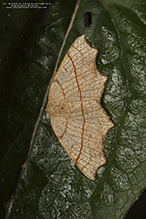Oak besma
(Besma quercivoraria)
Conservation • Description • Habitat • Ecology • Distribution • Taxonomy
| Hodges # | 6885 |
||
Conservation Status |
|||
| IUCN Red List | not listed |
||
| NatureServe | NNR - Unranked SNR - Unranked |
||
| Minnesota | not listed |
||
Description
Oak besma is a medium-sized to large typical geometer moth. It occurs throughout the United States except for California, and across southern Canada. It is most common east of the Great Plains. It is common in Minnesota. Adults are found from early May to late August in deciduous and mixed woodlands. Larvae feed on oak, birch, elm, poplar, willow, and white spruce.
Adults have slender bodies and relatively large wings, with a wingspan of 1 1⁄16″ to 1⅝″ (27 to 41 mm).
The antennae on the female are slender and thread-like. On the male the antennae are branched, feather-like, on both sides (bipectinate).
The wings are large and thin. Each wing has a projection on the outer margin, giving the moth a scalloped appearance. The background color is variable; yellow, pale tan, or light reddish-brown on the male, paler on the female. All wings are have dark veins and dark lines, and are peppered with dark scales. On the forewings there is a curved antemedial (AM) line and a scalloped subterminal (ST) line. The AM line extends to the forward (costal) margin but often ends before the inner margin. It is always dark and distinct. The ST line extends to the (costal margin but always ends well before the inner margin. It is usually faint. On all wings there is a distinct postmedial (PM) line that always extends from the costal to the inner margin. It forms a continuous, straight or slightly scalloped line across all four wings. There is usually a small black spot (discal spot) on the inner half of all wings. The discal spots are “almost always present” on the forewing and hindwing. On the female there is sometimes a dark smudge on the outer half of the forewing near the inner margin. On the male there is often dark shading beyond the PM line and along the AM line. On both sexes the scales at the base of the fringe are dark, creating a fine dark line on the outer margin.
The caterpillar, called a looper, is twig-like and up to 1 9⁄16″ (4 cm) long. The ground color is “exceedingly variable.” Early stages (instars) are green and do not have any wart-like bumps. Middle instars usually have some brown. The second segment of the thorax (T2) has a pair of dark, wart-like bumps on top (subdorsal). On the third abdominal segment (A3) there are similar subdorsal warts and a wart on each side. There are smaller warts on the side and near the underside (subventral) of A2. There is also a pair of small subdorsal warts on A1, A5, A6, and A8, and these may be well or poorly developed. The warts are usually reddish or blackish. Late instars may be brown, tan, or gray, or a combination of these, and the bumps are larger. There are 3 pairs of legs on the thorax, one on each segment, and just 2 pairs of leg-like structures (prolegs) on the abdomen, one pair on A6 and one pair on A10. The head is brown and black. Mature caterpillars are active from June onward.
Size
Wingspan: 1 1⁄16″ to 1⅝″ (27 to 41 mm)
Similar Species
Straw besma (Besma endropiaria) is paler overall and has lighter markings. There is no discal spot. The fringe scales are the same color as the wing background.
Habitat
Deciduous and mixed woodlands and forests
Ecology
Season
Two generations per year. Early May to late August.
Behavior
Adults rest with their wings spread flat. They are active at night and will come to lights.
Life Cycle
The pupa overwinters.
Larva Food/Hosts
Oak, birch, elm, poplar, willow, and white spruce
Adult Food
Distribution |
||
|
Sources 21, 24, 27, 29, 30, 71, 75, 82, 83. Biodiversity occurrence data published by: Minnesota Biodiversity Atlas (accessed through the Minnesota Biodiversity Atlas Portal, bellatlas.umn.edu, 9/27/2025). |
|
| 9/27/2025 | ||
Occurrence |
||
Common in Minnesota |
||
Taxonomy
Order
Lepidoptera (Butterflies and Moths)
Superfamily
Geometroidea (Geometrid and Swallowtail Moths)
Family
Subfamily
Ennominae (Typical Geometers)
Tribe
Ennomini
Genus
Besma
Subordinate Taxa
Synonyms
Endropia textrinaria
Meatnema aeliaria
Metanema incongruaria
Metanema quercivoraria
Metanema trilinearia
Common Names
oak besma
Glossary
Costal margin
The leading edge of the forewing of insects.
Instar
The developmental stage of arthropods between each molt; in insects, the developmental stage of the larvae or nymph.
Proleg
A fleshy structure on the abdomen of some insect larvae that functions as a leg, but lacks the five segments of a true insect leg.
Visitor Photos
Share your photo of this insect.
This button not working for you?
Simply email us at info@MinnesotaSeasons.com.
Attach one or more photos and, if you like, a caption.
Alfredo Colon |
 |
MinnesotaSeasons.com Photos
|

Slideshows
Oak Besma - Hodges#6885 (Besma quercivoraria)
Andree Reno Sanborn

Visitor Videos
Share your video of this insect.
This button not working for you?
Simply email us at info@MinnesotaSeasons.com.
Attach a video, a YouTube link, or a cloud storage link.
Other Videos
besma quercivoraria larvae
anupama jadhav

Visitor Sightings
Report a sighting of this insect.
This button not working for you?
Simply email us at info@MinnesotaSeasons.com.
Be sure to include a location.
Alfredo Colon
8/9/2019
Location: Woodbury, MN

Minnesota Seasons Sightings

